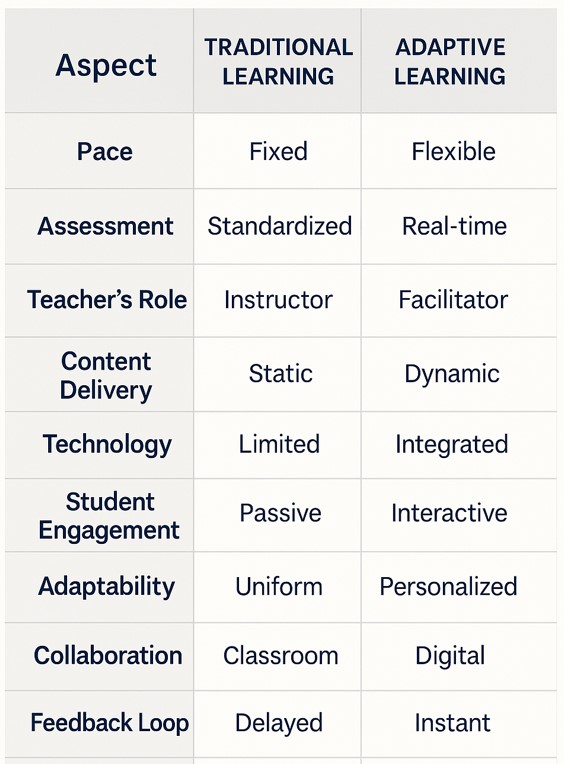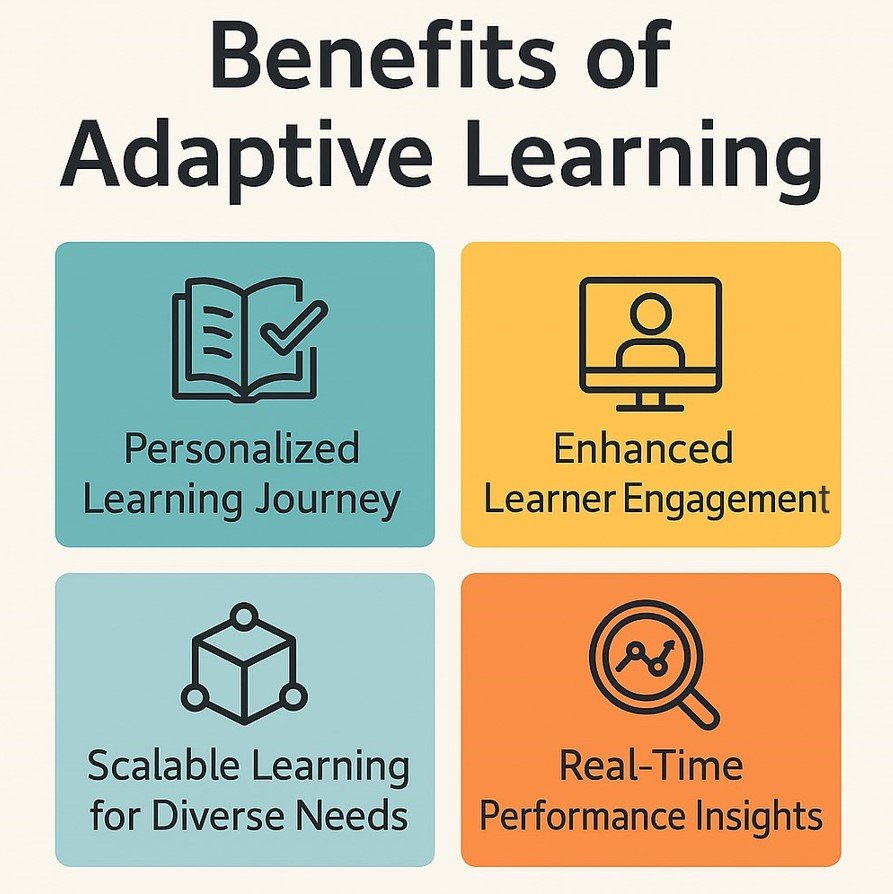In recent years, the education landscape has evolved dramatically with the rise of innovative learning methodologies. Among the most transformative advancements is adaptive learning, which redefines traditional education by offering a more personalized and dynamic approach to learning.
While traditional learning provides a structured and time-tested framework, adaptive learning leverages technology to deliver personalized experiences tailored to individual needs.
In this blog, we’ll explore the key differences between adaptive and traditional learning, highlighting their respective advantages and challenges.
What Is Traditional Learning?
For centuries, traditional learning has been the foundation of education, following a one-size-fits-all methodology. Classroom settings, instructor-led training, and standardized curricula define this approach, where students progress at the same pace, regardless of individual learning needs or preferences. Success is typically measured through standardized tests, assignments, and assessments, leaving little room for customization.
The greatest strength of traditional learning lies in its structure. This model has long fostered discipline, built a sense of community, and ensured consistent access to education. Instructors play a pivotal role, offering subject expertise and personalized guidance.
However, this rigidity also presents challenges. Students with different learning speeds and comprehension levels may struggle—some fall behind, while others remain unchallenged. The lack of adaptability makes it difficult to cater to diverse learning needs, often leaving gaps in understanding or engagement.
The Rise of Adaptive Learning
Adaptive learning leverages technology, data analytics, and artificial intelligence (AI) to create personalized educational experiences. By continuously assessing a learner’s strengths, weaknesses, and preferences in real-time, adaptive learning platforms tailor course recommendations, quizzes, and feedback to optimize learning outcomes.
Unlike traditional learning, adaptive systems allow students to progress at their own pace. If a learner struggles with a concept, the system provides additional resources to reinforce understanding. Conversely, if they master a topic quickly, they can move on to more advanced material, ensuring continuous engagement and preventing stagnation.
For example, platforms like DreamBox and Knewton use adaptive learning to transform subjects like mathematics into dynamic, personalized learning experiences. This approach is equally valuable in corporate training, where employees can focus on skillsets relevant to their roles, enhancing both efficiency and productivity.
Key Differences:
Traditional vs Adaptive Learning

Traditional and adaptive learning differ significantly in their approach to education. Traditional learning follows a fixed pace where all students progress uniformly, with standardized assessments and an instructor-led environment. Content delivery is static, and technology integration is minimal, making the learning experience more rigid and less personalized.
On the other hand, adaptive learning tailors education to individual needs. It offers flexible pacing, real-time assessments, and a facilitator-led approach that supports personalized learning. The content is dynamic and adjusts based on the learner’s strengths and weaknesses, with technology playing a central role in enhancing engagement and interactivity.
Moreover, collaboration and feedback mechanisms vary greatly between the two approaches. Traditional learning relies on classroom-based peer discussions and delayed feedback through periodic tests. In contrast, adaptive learning fosters digital collaboration and AI-driven recommendations, providing instant, data-driven feedback for continuous improvement.
The traditional system emphasizes uniformity, while the adaptive model celebrates individuality.
Benefits of Adaptive Learning
The adaptability of this new-age learning system holds immense potential:

- Personalized Learning Journeys:
In corporate training, a one-size-fits-all approach is rarely effective. Beetsol LMS tailors learning journeys according to each employee’s skill preferences, feedback, and compliance needs. Whether it’s for sales enablement or regulatory training, the platform delivers targeted courses that accelerate learning and boost performance, ultimately enhancing the L&D efficiency for organizations of every size. - Enhanced Learner Engagement:
High engagement is vital for effective customer training. Beetsol LMS creates an immersive learning environment by building detailed learner profiles based on individual interests and skills. This enables tailored course recommendations that align precisely with the customers’ preferred products or services of choice, ultimately boosting ROI. - Real-Time Performance Insights:
For fast-paced industries like QSR training, timely insights are essential. Beetsol LMS offers real-time dashboards that spotlight knowledge gaps and learning trends. This enables managers to swiftly adjust training strategies, ensuring that every training investment translates into tangible business outcomes. - Scalable Learning for Diverse Needs: From small teams to large enterprises, adaptive learning unlocks true potential. Beetsol LMS scales seamlessly across various use cases—from corporate training to customer education—delivering transformative, personalized learning journeys that drive measurable outcomes while reducing the Total Cost of Ownership for SMBs and beyond.
One potential challenge with adaptive learning is its reliance on well-organized data. The system’s ability to deliver truly personalized experiences depends on consistent and accurate data inputs. Fortunately, modern adaptive platforms like Beetsol LMS are designed to integrate smoothly with existing data systems, ensuring that even organizations with lean data environments can fully benefit from adaptive learning.
The Role of Educators in Both Models
In traditional learning, educators are at the heart of the classroom. They design lesson plans, lead discussions, and assess student performance, fostering rich interpersonal connections and a structured environment. In contrast, adaptive learning shifts some of these responsibilities to technology. However, educators remain vital—as facilitators who interpret data, offer supplemental support, and keep learners motivated. Adaptive systems, such as Beetsol LMS, redefine the instructor’s role without diminishing its importance.
Combining the Best of Traditional and Adaptive Learning
Beetsol LMS bridges the gap between the tried-and-true methods of traditional learning and the personalized power of adaptive systems. Learners benefit from the flexibility and tailored pathways of adaptive technology while still enjoying the community-building and direct guidance inherent in instructor-led settings. This blend supports diverse training needs—be it corporate training, customer education, or other learning environments—enhancing overall performance and efficiency.
They Way Forward
As the educational landscape evolves, adaptive learning is increasingly gaining momentum across sectors, from corporate training and higher education to K-12 classrooms. Research from sources like Informing Science and Elm Learning suggests that adaptive systems can democratize education by addressing individual needs while complementing traditional methods.
Although technology plays a key role in enabling personalized learning experiences, the value of traditional methods in fostering interpersonal skills, discipline, and community remains indispensable.
Conclusion
Both traditional and adaptive learning offer unique benefits. Traditional learning excels at providing structure, fostering interpersonal connections, and maintaining community engagement. Meanwhile, adaptive learning—exemplified by platforms like Beetsol LMS—revolutionizes educational experiences by offering personalized pathways, real-time analytics, and enhanced flexibility.
The future of education lies in integrating these methodologies to create hybrid models where adaptive technology complements traditional teaching. This harmonious blend ensures that education remains inclusive, effective, and empowering for all learners.
